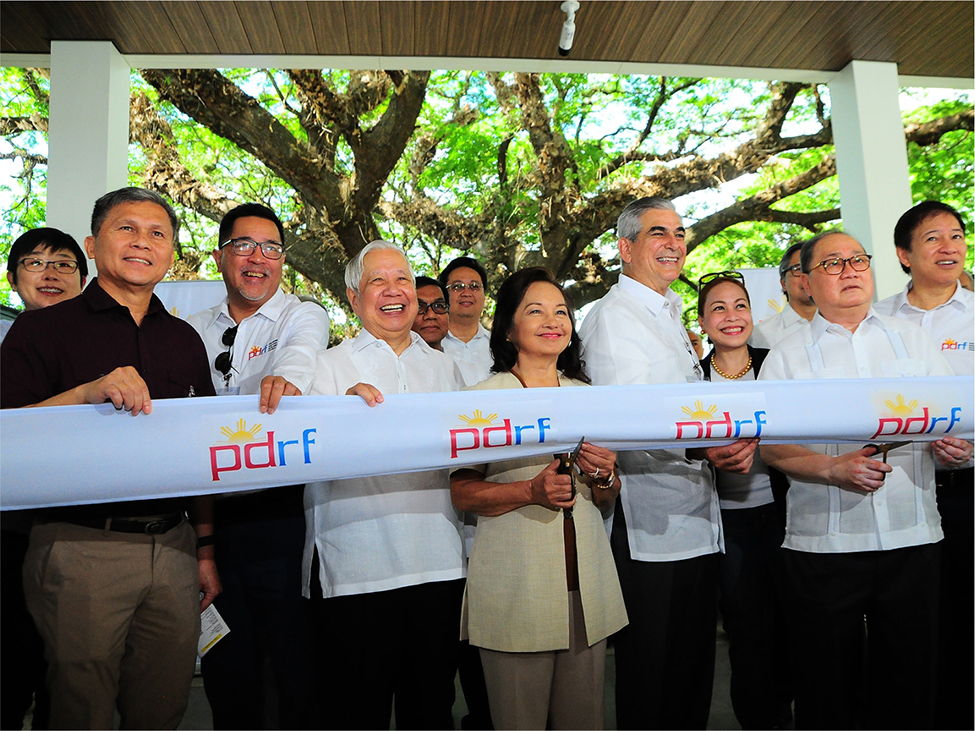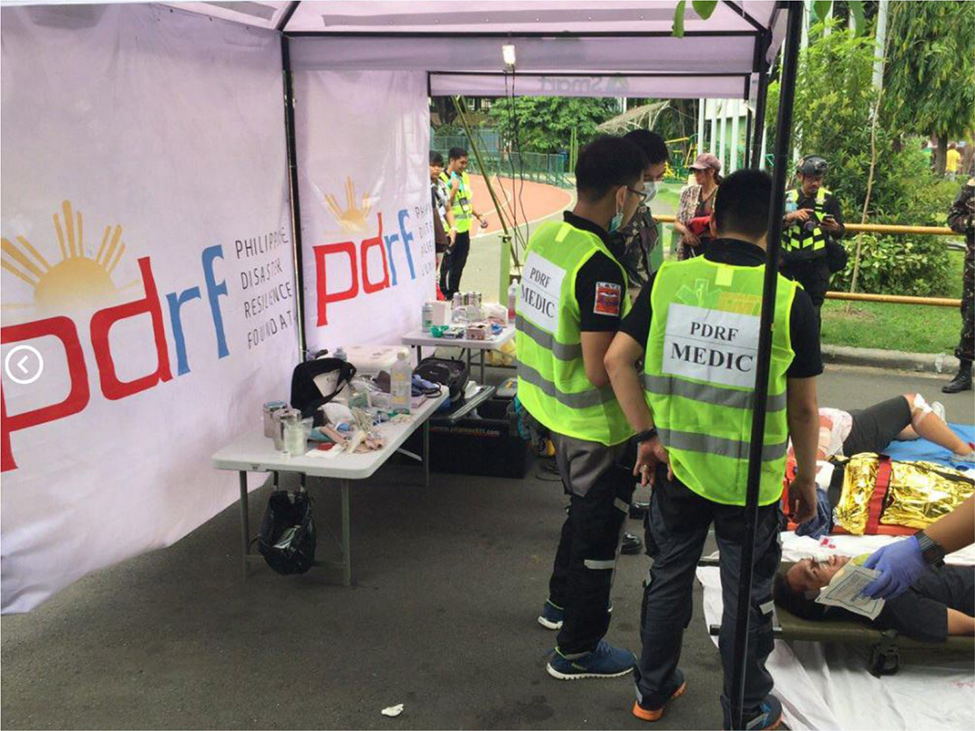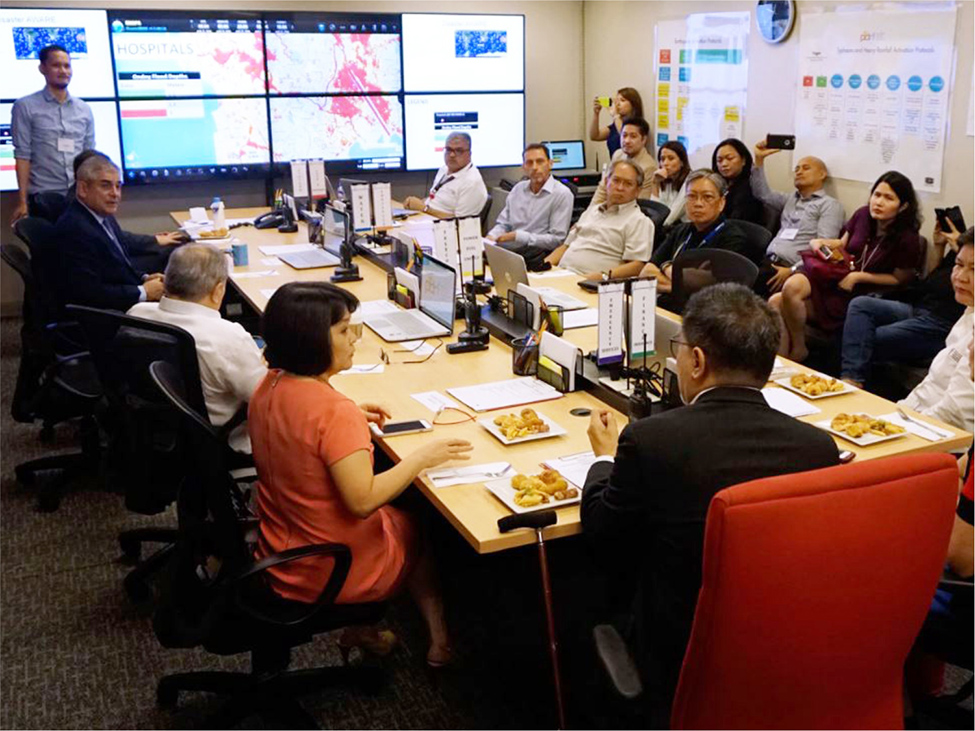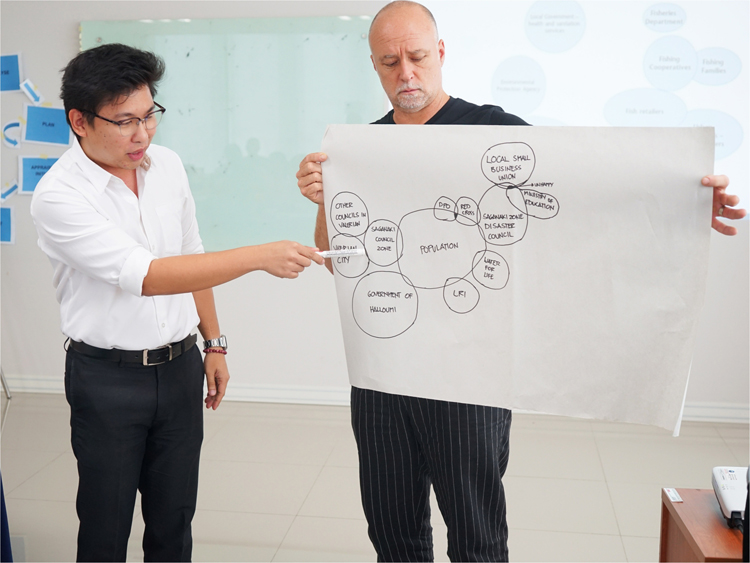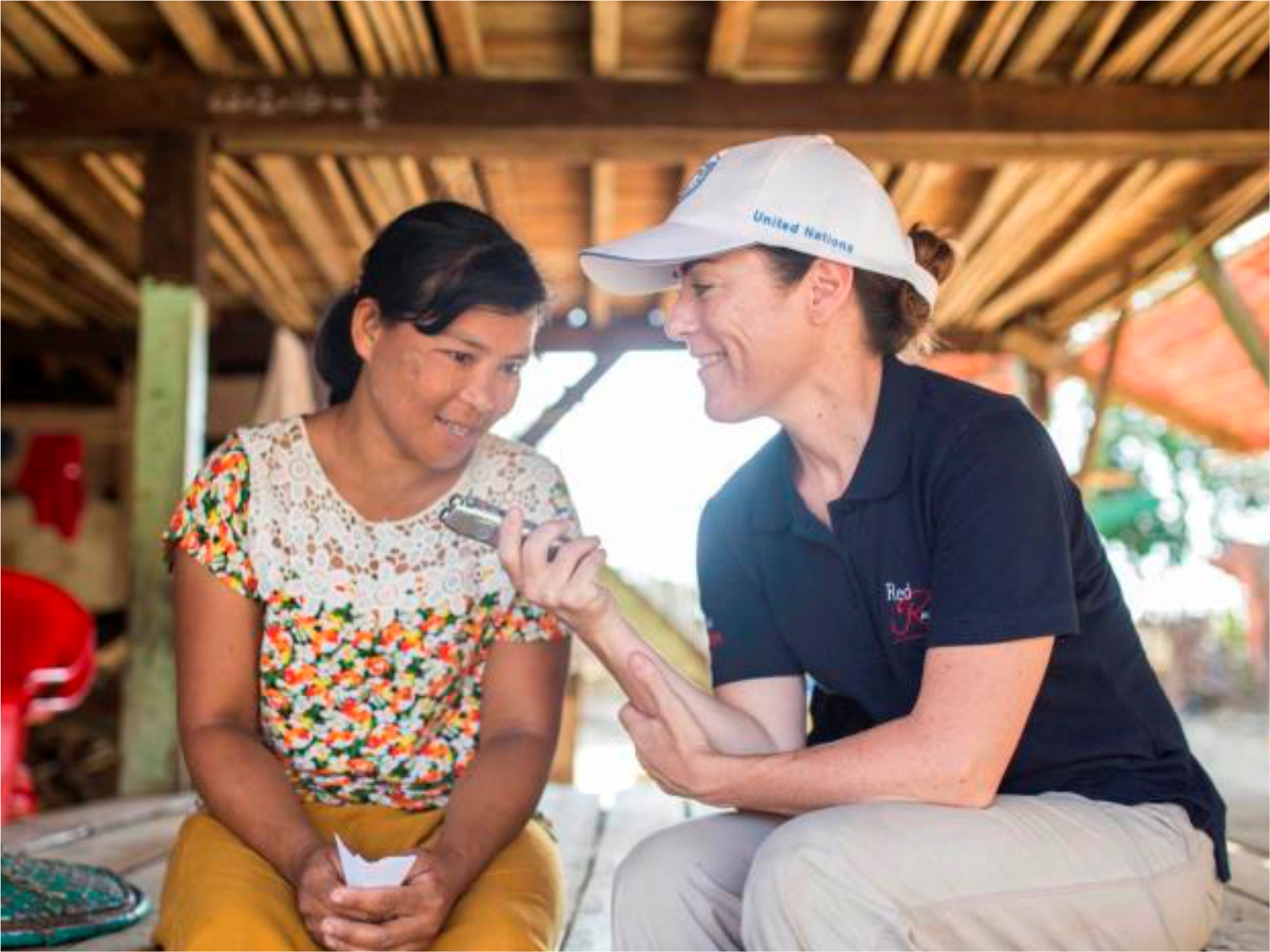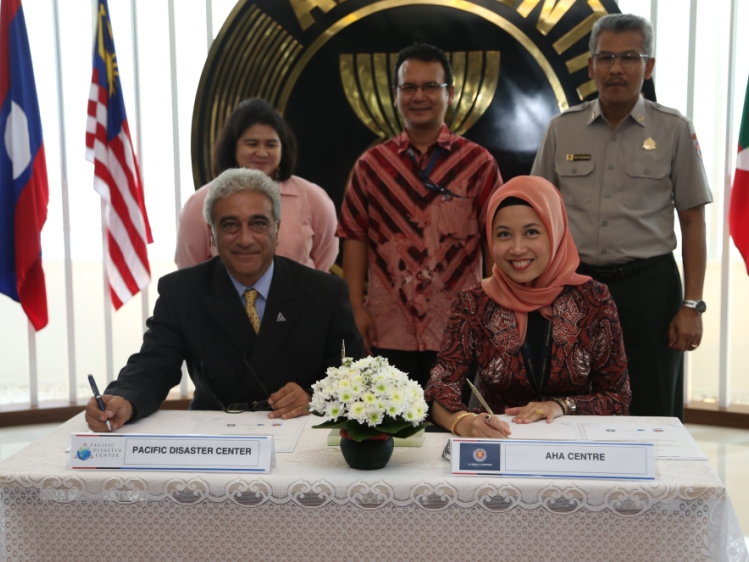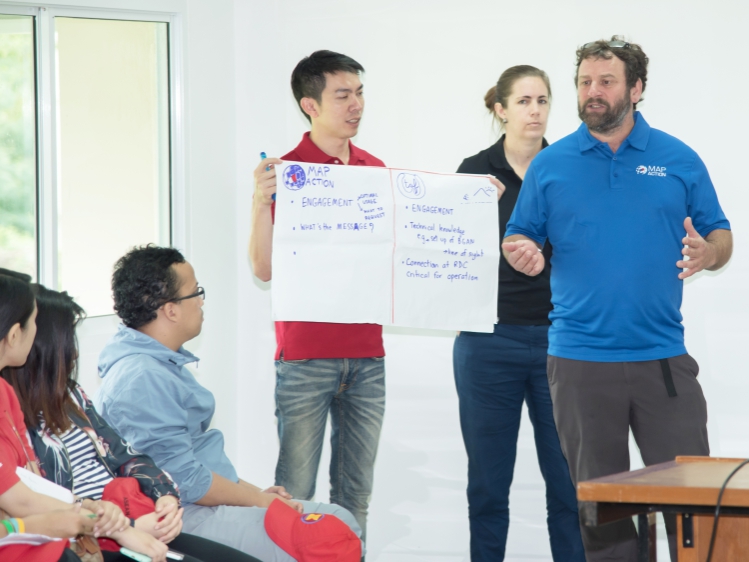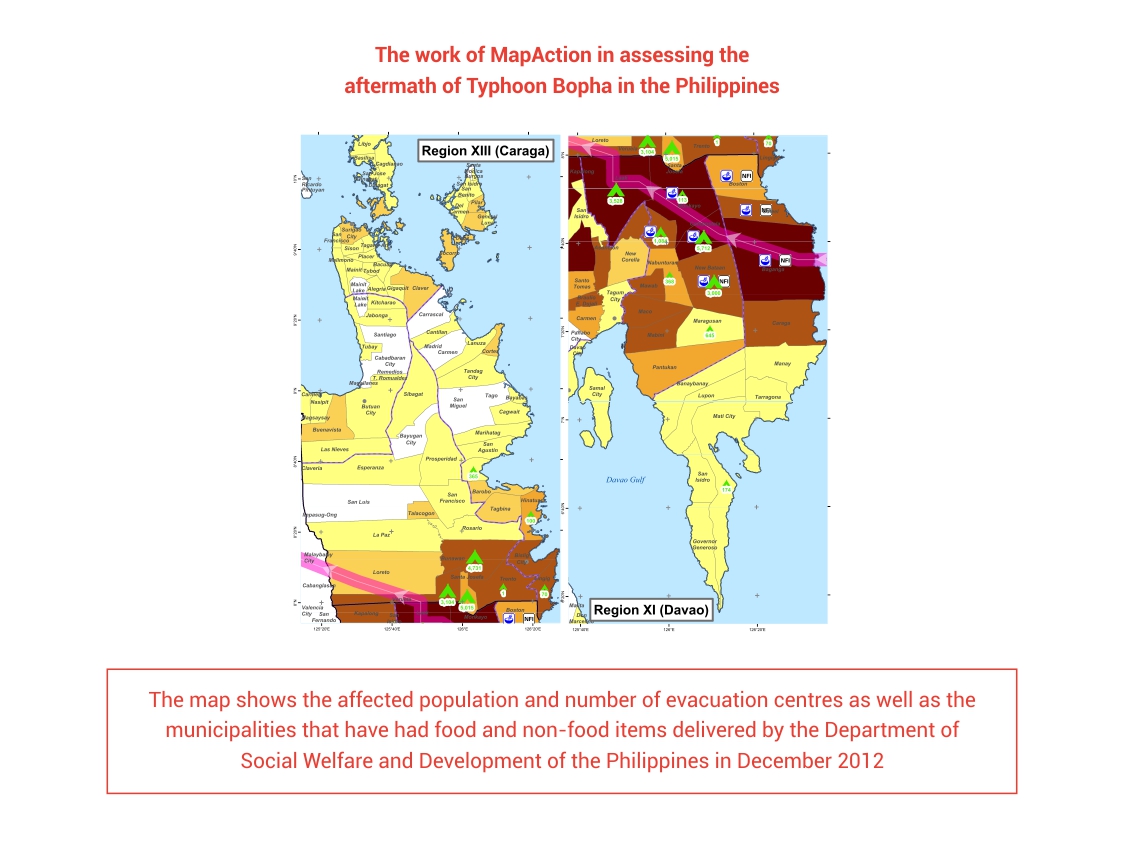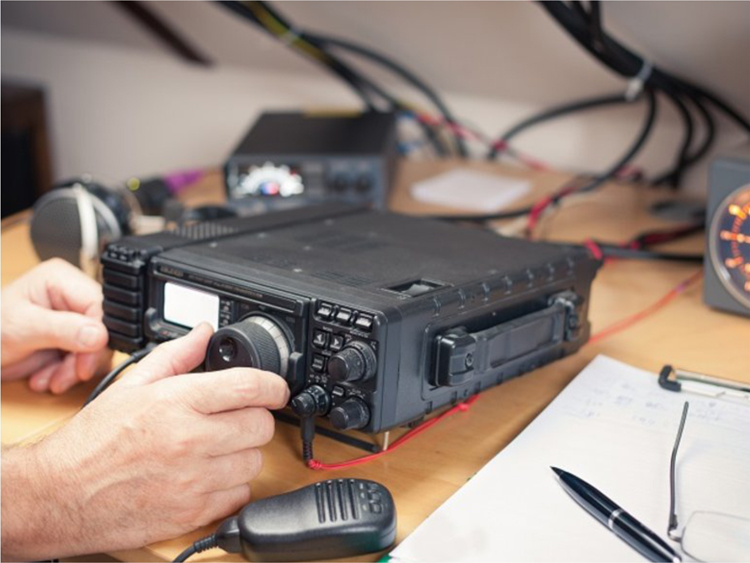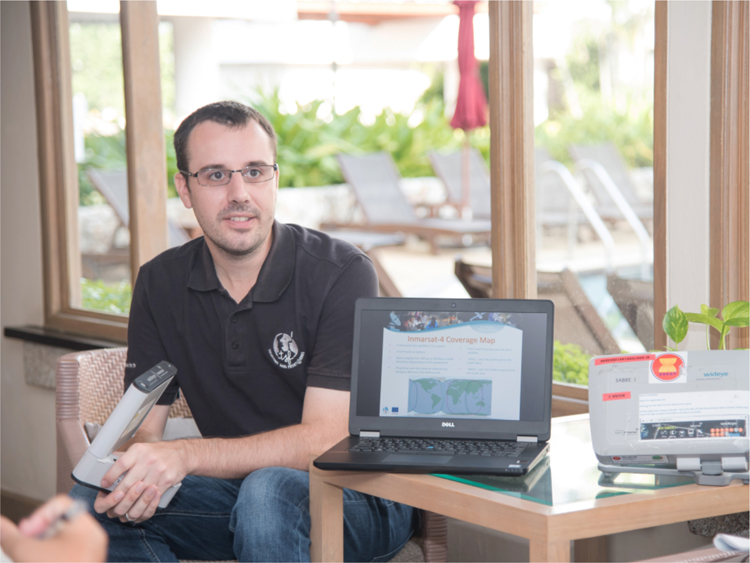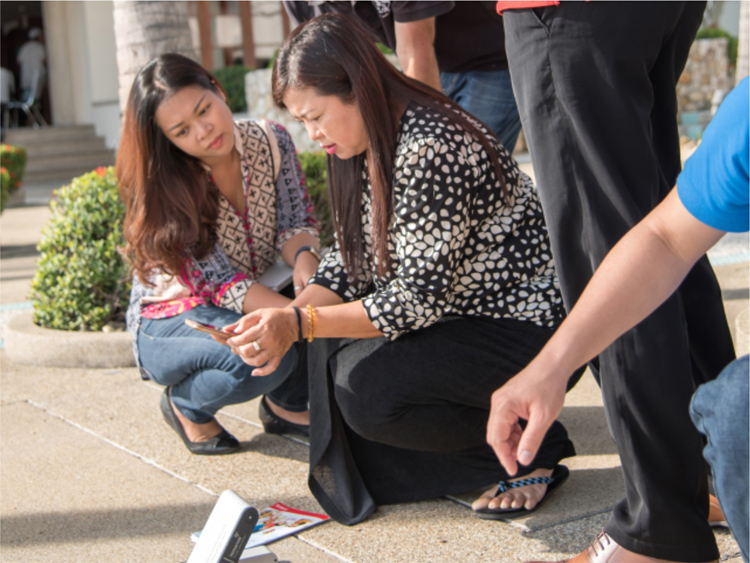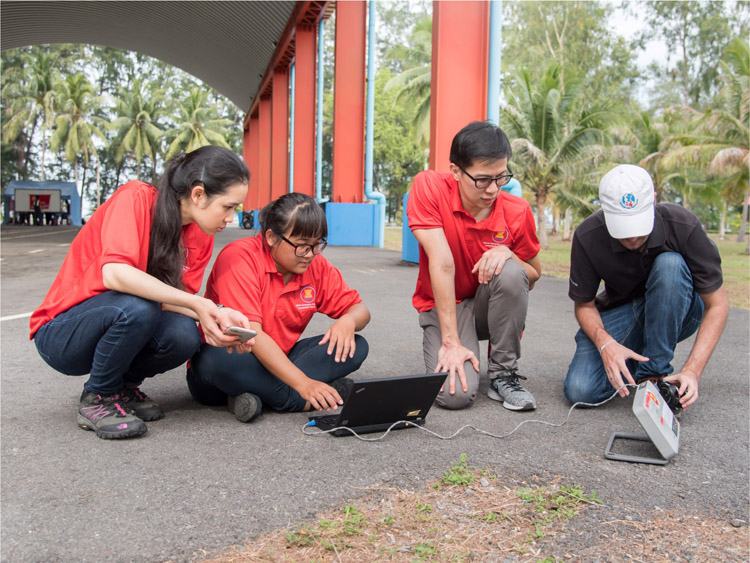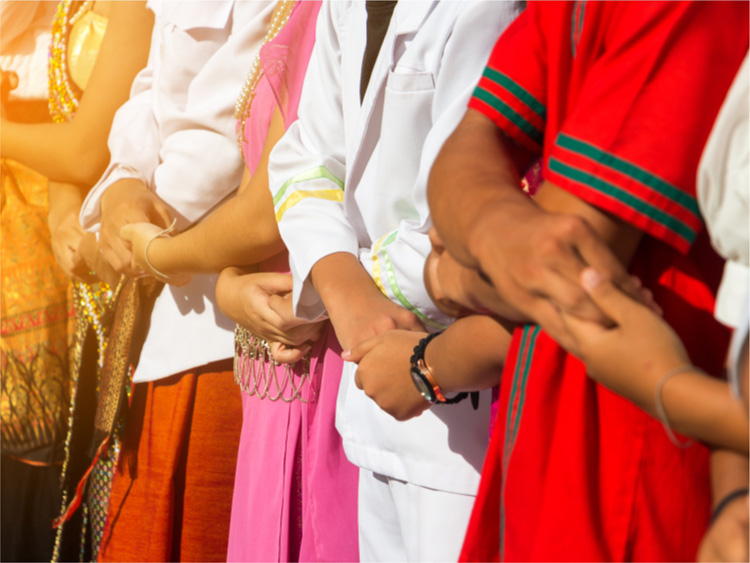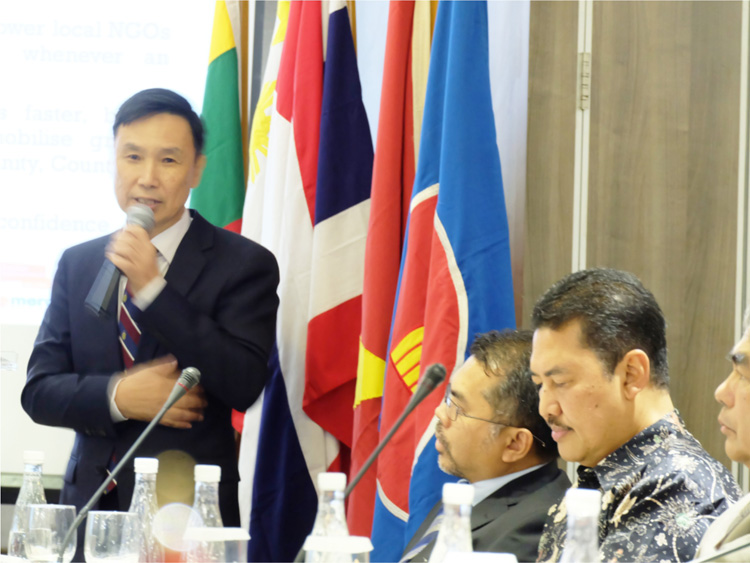Vol 43-PDRF The Philippine Disaster Resilience Foundation

PDRF
THE PHILIPPINE DISASTER RESILIENCE FOUNDATION
The Philippine Disaster Resilience Foundation (PDRF) is a unique organisation, who forms the major coordinating body for the Philippines’ private sector engagement and support on disaster management. The ASEAN region has become increasingly aware of the importance of private sector engagement in disaster management field, as well as the value that such engagement can foster, with organisations such as the PDRF providing strong examples of the strong, responsive and skilled resources that can support the overall disaster management efforts of this disaster-prone region.
Over recent years, the AHA Centre has turned its focus more heavily to the engagement of the private sector throughout its disaster management work, based on the reasons above, alongside the private sector’s own realisation that disaster is something that impacts them heavily – and that they need to do more to support with ongoing efforts. The PDRF mission and work form a solid match with the AHA Centre, therefore their partnership is mutually beneficial on many levels. The partnership was first formalised in April 2017, with Ms. Adelina Kamal, the (then acting) Executive Director of the AHA Centre, and PDRF President Rene Meily putting pen to paper to formalise this valuable agreement.
The PDRF itself is composed from a team of highly committed professionals who work alongside field experts and reputable humanitarian institutions to organise, coordinate, and solidify the commitment of the private sector within overall disaster management efforts. The PDRF has been a leader in effective reconstruction measures that address the needs of disaster-stricken communities, with their programmes developed for post-disaster recovery in key sectors such as shelter, livelihood, education, environment and water, infrastructure, sanitation, and health. Alongside this, they operate their own state-of-the-art operations and communications centre, engage in community resilience programmes, and support the business sector across a range of elements related to disaster preparedness as well as business resilience in the event of disaster.
Within this context, the AHA Centre PDRF partnership focuses towards supporting and advocating increases in public knowledge and awareness regarding disaster management. Through PDRF’s support of One ASEAN One Response, there will be a range of exchanges and knowledge sharing activites, that will be mutually reliant on each other’s assets and expertise, in order to increase and boost the capacity and capability in responding to disaster. In addition, the partnership will encourage private sector and start-up businesses to be more engaged, and share more ideas for disaster preparedness, disaster risk reduction and management, and resilient recovery.
Written by : Valerie Bayhon, William Shea | Photo : PDRF
- Published in Partnership
Vol 41-RedR Australia

RedR Australia
The ASEAN region, being prone to a range of natural disasters, aims to be a step ahead in delivering response to such disasters when they strike. To achieve this, well-trained and prepared human capital is required, with strong teams developed through relevant and up-to-date seminars and workshops. Through the recent formalisation of a long-standing working partnership between RedR Australia and the AHA Centre, both parties aim to mutually promote, develop, and strengthen their cooperation in disaster management to further improve response for the ASEAN region’s communities.
RedR Australia is a non-governmental, international humanitarian agency that provides disaster management training across the world. One of their key objectives is to help rebuild and support communities to recover immediately after disaster strikes, by both delivering and equipping key actors with appropriate and efficient humanitarian skills. Adelina Kamal, the Executive Director of AHA Centre, and Kirsten Sayers, the Chief Executive Officer of RedR Australia, recently signed and formalised a partnership through a Memorandum of Intent, on the side lines of the 8th Meeting of the Governing Board of the AHA Centre in Kuala Lumpur, Malaysia on the 27th of June 2018.
The partnership is channelled through the “Australia Assists – Technical Assistance in Disaster Risk Management” programme, managed and co-designed by RedR Australia and the Australian Government’s Department of Foreign Affairs and Trade (DFAT). The programme aims to develop and increase the capacity of deployable civilian resources that meet humanitarian policy and procedure requirements and standards. The formation of collaboration between RedR Australia and AHA Centre will not only strengthen disaster response, but also develop stronger disaster management capacity within the region. The platform of the partnership has been undertaken with the intention of providing the highest quality disaster response and management practices within a constantly changing environment and context, and more importantly, to build resilience and improve the quality of humanitarian action to alleviate suffering and save lives.
This MoI stands as a bilateral recognition of the value that both parties’ ongoing engagement has created, and to expand on this, the formalised partnership will allow both parties to engage on a wider level. It aims to provide the ASEAN region with access to a deeper pool of deployable expertise, efficient roster management practices, effective monitoring, evaluation, accountability and learning (MEAL) processes, appropriate and effective risk management, and more opportunities to develop disaster-related activities with RedR Australia.
Since 2016, RedR Australia’s expertise has also been integrated within the AHA Centre’s existing training programmes, such as the AHA Centre Executive (ACE) Programme, in which they have provided specific training modules on project management elements. Such engagement has been an integral part of the ACE Programme, which focuses specifically towards developing ASEAN leaders from all 10 Member States, who hold the capacity and skills to lead the region in response and operations when a disaster strikes. Alongside the new overall MoI, RedR Australia and the AHA Centre have also agreed to continue and strengthen their partnership through the ACE Programme, developing stronger, more specific training materials and engagements as part of ACE Programme Phase 2, being implemented from 2018-2020.
Written by : Valerie Bayhon | Photo : RedR Australia, AHA Centre
- Published in Partnership
Vol 36-Pacific Disaster Centre

PACIFIC DISASTER CENTRE
Strengthening Disaster Preparedness across Asia-Pacific
with the Pacific Disaster Centre
THE PACIFIC DISASTER CENTER (PDC) IS A HAWAIIAN-BASED ORGANISATION WITH A FOCUS TOWARDS DEVELOPING TECHNOLOGICAL INNOVATIONS FOR IMPROVING DISASTER MITIGATION, PREPAREDNESS, RESPONSE, AND RECOVERY. FOR ALMOST TWO DECADES, PDC HAS DELIVERED A VARIETY OF TOOLS AND SERVICES TO THE GLOBAL DISASTER MANAGEMENT COMMUNITY – INCLUDING TO THE AHA CENTRE. SUCH TOOLS AND SERVICES INCLUDE GLOBAL MULTI-HAZARD DISASTER MONITORING, EARLY WARNING MECHANISMS AND DECISION SUPPORT SYSTEMS, RISK AND VULNERABILITY ASSESSMENT TOOLS, MODELING AND VISUALISATION PLATFORMS, SIMULATION EXERCISE SUPPORT, AND A RANGE OF CAPACITY DEVELOPMENT ACTIVITIES.
ASEAN’s collaboration with the PDC began in mid-2004, prior to the Indian Ocean Tsunami, and the PDC has been constantly involved in the implementation of the ASEAN Agreement on Disaster Management and Emergency Response (AADMER). More recently, the PDC – supported by the United States Government through its US Agency for International Development (USAID) programmes – has worked with ASEAN and the AHA Centre to implement programmes such as the AADMER Work Programme for Risk Assessment, Early Warning, and Monitoring Activity (2010-2015), the AHA Centre Information Communication Technology (ICT) Gap Analysis, and the development of a Disaster Monitoring and Response System (DMRS) powered by PDC’s DisasterAWARE™ platform.
The most notable recent collaboration between the two Centres has been the development of the DMRS. The system was initiated following an offer made by the United States’ President Barack Obama at the First ASEAN-US Leaders’ Meeting in November, 2009, in Singapore. The DRMS is supported by the United States Government through the USAID and US Department of State-funded ASEAN-US Technical Assistance and Training Facility. The United States has been an ASEAN Dialogue Partner since 1977.
The DMRS enables the AHA Centre to integrate all monitoring of hazard data within one system. The system compiles and transforms various hazard and other natural disaster information from national and international disaster monitoring agencies into a regional, event-tracking and decision-support tool, further enhanced by its utilisation of maps and modelling applications. Through this integration, the AHA Centre operations team can immediately obtain a global overview of any situation, which improves response times and leads to more efficient use of relief resources.
“I would characterise PDC as a very committed and sustainable partner of the AHA Centre. Through their support, we now have comprehensive disaster monitoring tools that allow us to monitor hazards in an almost real-time manner. The early warning alerts allow us to plan ahead of time,” explains Arnel Capili, the Operations Director of the AHA Centre.
Following more than a decade of collaboration, The PDC and the AHA Centre signed a new Memorandum of Intent (MOI) on the 5th of June, 2017, at the AHA Centre’s headquarters in Jakarta.
The MOI aims to strengthen the two Centres’ ongoing partnership in advancing disaster risk reduction and regional cooperation, including steps to progress the vision of One ASEAN One Response. The PDC and AHA Centre will continue working together to pursue new endeavours to support the vision, including a project to conduct a regional risk assessment for the ASEAN Member States that will support the development of sound policies for risk reduction across the region.
Written by : Carla Budiarto | Photo : AHA Centre
- Published in Partnership
Vol 40-MAP Action

MAPACTION
Mapping is perhaps one of the first things that springs to mind when we think of disaster preparedness and response. It forms an integral element of determining affected areas, infrastructure and terrain, as well as access for supplies both in preparedness planning and when disaster strikes. MapAction has been supporting the emergency management sector with professional mapping services, sending teams to respond to around 80 disasters across the world, and impacting the lives of tens of millions since its establishment in 2002. Based on such experience, and the importance of mapping within the disaster management context, the AHA Centre and MapAction recently formalised their working partnership through the signing of a Memorandum of Intent (MoI) during the 8th Meeting of the Governing Board of the AHA Centre held in Kuala Lumpur, Malaysia, on 27 June 2018.
Although the ink is still drying on the formal partnership between the AHA Centre and MapAction, the two institutions have already forged a strong working relationship throughout recent years, primarily engaging through the AHA Centre-led ASEAN Emergency Response and Assessment Team (ASEAN-ERAT) training programme. MapAction has provided valuable support to participants in the ASEAN-ERAT workshops, with hands-on training using state-of-the-art mapping applications that support the work of ASEAN-ERAT during disaster response. Training on the use of these applications has allowed ASEAN-ERAT members to engage in data visualisation and communication of the impacts of disasters during deployments on the frontline, and such working efforts paved the way for the development of the AHA Centre and MapAction’s formal partnership.
This recently signed MoI will ensure that a range of activities will be undertaken with a focus to mutually-beneficial outcomes for both the AHA Centre and MapAction. Under the MoI, MapAction will engage their skills and experience to support the development and implementation of emergency management in the region by providing GIS-based mapping support for ASEAN-ERAT deployments to regional and international emergency response operations, as well as providing GIS-based remote mapping material support for the AHA Centre upon request. Accordingly, the AHA Centre will support MapAction’s work by facilitating access to disaster-affected areas, including obtaining visas and customs clearance for MapAction’s equipment, and also identifying and facilitating potential collaboration opportunities between ASEAN Member States and MapAction to enhance information management and the use of GIS in emergency preparedness and response efforts.
The two parties will also embark on a range of shared projects, with the aim to strengthen the long-term sustainability and development of disaster management capacity in the ASEAN region. Such efforts will include a jointly-developed training curriculum for an ASEAN-ERAT specialised course on GIS mapping and technology, alongside practising joint deployment within the ASEAN Regional Disaster Emergency Response Simulation Exercise (ARDEX) and ASEAN Regional Forum Disaster Relief Exercise (ARF DiREx) implementations. Such mutually-beneficial partnerships form a key element of the AHA Centre’s partnership strategy, as summed up by the AHA Centre’s Executive Director Ms. Adelina Kamal,
“The knowledge and practical skills shared by MapAction through joint training and exercises will allow the AHA Centre and our ASEAN-ERAT members to better assist the disaster-affected country and enhance coordination with other humanitarian actors in line with the spirit of One ASEAN One Response.”
Written by : William Shea | Photo : AHA Centre, MapAction
- Published in Partnership
Vol 37-Télécoms Sans Frontières Connecting People During Emergencies

TÉLÉCOMS SANS FRONTIÈRES
Connecting People During Emergencies
Télécoms Sans Fontières (TSF) was founded in 1998 and is currently the world’s leading non-profit emergency telecommunications organisation. TSF provides emergency communications facilities for affected populations and humanitarian aid workers during disasters. TSF has an established office in the United States, as well as three operational bases in France, Nicaragua, and Thailand. Over the last 20 years, TSF has developed a roster of worldwide IT and telecoms specialists, ready for deployment within a few hours’ notice of the onset of a disaster. TFS has built its reputation as one of the first responders on the ground when disaster strikes. TFS is also part of the first responder for the UN Emergency Telecommunications Cluster, and also a member of the UN Working Group on Emergency Telecommunications (WGET). TSF is also engaged as a partner of the European Civil Protection and Humanitarian Aid Operations (ECHO) and International Telecommunication Union (ITU).
October 2010 was the first time ASEAN facilitated TSF’s deployment within ASEAN Member States, during the response to the Mentawai earthquake and tsunami in Indonesia. This deployment was initiated at the request of the Office of the President of Indonesia, and in coordination with the Indonesian National Disaster Management Authority (BNPB). Since 2017, ASEAN, through the AHA Centre, has engaged TSF to train ASEAN Emergency Response and Assessment Team (ERAT) regarding emergency ICT processes. The relationship between the AHA Centre and TSF has since been formalised through a Memorandum of Intent (MOI) signed on the 5th of January 2018. The MOI clarifies the facilitation of cooperation, and exchange of information, assets and ideas of mutual interest and benefit for both entities. Through the MOI, TSF also re-affirms its commitment to support ASEAN in enhancing the capacity of ASEAN ERAT for emergency ICT preparedness and response–a key element in the overall One ASEAN, One Response vision.
The partnership between AHA Centre and TSF involves cooperation on preparedness, as well as during emergency responses. Preparedness activities include training and joint deployment to exercises. Insofar, TSF has supported the implementation of three ASEAN-ERAT induction courses since April 2017. For emergency response, this partnership is crucial to support the deployment of ASEAN-ERAT, particularly during early stages when telecommunication systems are usually down.
“Emergency telecommunication will also serve as the backbone to support the role of ASEAN-ERAT in facilitating the coordination of ASEAN response on the ground. During an emergency, TSF will deploy its experts alongside ASEAN-ERAT responders to support their communication. Deployment of TSF experts and their equipment will also leverage ASEAN-ERAT’s capacity to extend our emergency communication support for the affected government and other institutions,” stated Janggam Adhityawarma, Assistant Director for Preparedness & Response with the AHA Centre.
The AHA Centre and TSF will continue to support each other during emergency deployments and through capacity building exercises. We are now looking forward to conduct a joint deployment for the ASEAN Regional Disaster Emergency Response Simulation Exercise (ARDEX) 2018 in Indonesia, to further develop our collaboration in supporting affected ASEAN Member States in times of disaster.
Written by : Carla Budiarto | Photo : AHA Centre/Dandi Rahman
- Published in Partnership
Vol 38-AADMER Partnership Group (APG)

AADMER
PARTNERSHIP GROUP (APG)
The AADMER Partnership Group (APG) is a consortium of seven international civil society organisations, formed to support the implementation of the ASEAN Agreement on Disaster Management and Emergency Response (AADMER). The APG works with the ASEAN Committee on Disaster Management (SCDM) and its Working Groups, the AHA Centre, and the ASEAN Secretariat, aiming towards a “people-centred implementation of AADMER”. It undertakes this function by raising awareness of AADMER, and by facilitating the engagement of civil society organisations throughout AADMER discussions and implementation. Currently, the APG operates in seven ASEAN Member States, namely, Cambodia, Indonesia, Lao PDR, Myanmar, the Philippines, Thailand and Viet Nam. The APG’s members comprise of representatives from ChildFund International, HelpAge International, Mercy Malaysia, Oxfam, Plan Pnternational, Save the Children International, and World Vision International.
The APG forms the bridge between ASEAN’s work in disaster management and the key stakeholders within civil society organisations – whose proximity and reach with local communities forms a key element of all disaster management processes. Through a working partnership with the APG, the AHA Centre (and other ASEAN bodies) can ensure increased participation and understanding within the communities they serve. Since 2009, the AADMER Partnership Group has been working closely alongside the ACDM and its Working Groups, the ASEAN Secretariat, and the AHA Centre, on the implementation of AADMER for the ASEAN region. During these early years, ASEAN governments and the APG identified proposed areas of partnership between ASEAN and civil society organisations – including in disaster risk assessment and early warning – as well as practical actions towards preparedness, prevention and mitigation of disaster.
The APG works with the AHA Centre throughout a range of its programmes and process developments, ensuring the all-important community engagement aspect is present throughout the AHA Centre’s efforts. APG members have also been very active in supporting the ASEAN Emergency Response and Assessment Team (ERAT) programme, as well as sending representatives to take part in the ASEAN ERAT trainings either as participants, trainers or observers. The APG often collaborates with the AHA Centre during disaster response, providing great support within a number of response efforts such as Typhoon Haiyan in 2013, and the Myanmar floods in 2015.
The group also played a key role in the AHA Centre’s development of a lessons learned document after Typhoon Haiyan. The involvement of the APG ensured valuable and relevant local insight and feedback within this outcome. Currently, the APG – in consultation with the AHA Centre – are developing a concept note on a Regional Alliance for Collective Emergency Response (RACER), under the CSO Partnership Framework (ACPF), and as part of the implementation of the AADMER Work Programme 2016-2020.
Dr. Heng Aik Cheng of MERCY Malaysia, and the Chair of the APG, emphasised the importance of the partnership during the recent One ASEAN One Response workshop in Jakarta, stating that the strength of civil society organisations lies in their proximity with populations affected by disaster. Staff from such organisations speak the local language, and are best placed to deliver important information and engage local stakeholders in the early stages of emergencies. Such a context is also highly valuable for preparedness engagements, therefore underlying the importance of partnerships such as seen between the APG and AHA Centre.
Written by : Carla Budiarto | Photo : AHA Centre
- Published in Partnership
Vol 39-JAPAN ASEAN Integration Fund


JAPAN–ASEAN
INTEGRATION FUND
The Japan-ASEAN Integration Fund (JAIF), officially established in early 2006, is a specific funding mechanism developed by the Government of Japan to support the continuous development of the ASEAN Community. Since its establishment, with contributions totaling over 650 million USD, JAIF has strengthened the relationship between Japan and ASEAN across a range of areas. Guided through the implementation of the ASEAN 2025: Forging Ahead Together blueprint, JAIF has funded and supported multiple projects related to disaster management, counter-terrorism, economic integration, youth exchanges and cultural understanding. Based on this shared interest in disaster management, the Government of Japan through JAIF has been an integral partner for the AHA Centre (and by extension disaster management in ASEAN) since the programme’s founding years.
This shared interest has been a key platform for a partnership that was forged during the AHA Centre’s early days in 2011, with the Japanese Government’s support (as one of the ASEAN Dialogue Partners) materialising within the AHA Centre-JAIF partnership functions. Support has not only been in financial form, but also through capacity development and knowledge and skills sharing across a range of programmatic functions. Both parties hold extensive and relevant portfolios in disaster management – a reality which allows for mutual benefit within the partnership context. Due to Japan’s close geographic proximity to the ASEAN region, both parties are explicitly intertwined, with much to gain from a close and strong relationship. The Government of Japan and ASEAN use this context to increase the interoperability and interaction of processes, mechanisms and skills within their respective disaster management sectors. As a result of Japan’s deep experience in managing and responding to large-scale natural disaster within its borders, JAIF has allowed the AHA Centre to tap into some of the most extensive knowledge and resources in the world, while allowing Japan’s access to regional knowledge and contacts, and the opportunity to further engage with its closest neighbours.
“As a Dialogue Partner, Japan actively cooperates and takes initiatives to strengthen cooperation on disaster management in the ASEAN region. Since its establishment in year 2011, the JAIF Management Team (JMT) has been closely working with the AHA Centre to conceptualise and formulate project proposals and implement significant and successful projects in support of fulfilling the AHA Centre’s mandate. For JMT, the collaboration with the AHA Centre only makes JAIF supported projects in disaster management better and more aligned with the needs of the region,” said Zin Aung Swe – the Programme Coordinator of JAIF Management Team.
Historically, JAIF has been one of the key support mechanisms for a range of ASEAN disaster management functions – in particular elements such as the Disaster Emergency Logistic System for ASEAN (DELSA) and the AHA Centre Executive (ACE) Programme – throughout the AHA Centre’s first six years of existence. The finance, skills and knowledge provided through these original programmes helped ensure longevity and stability of disaster management resources for the ASEAN region. Due to such success in the implementation of these programmes during the AHA Centre’s first six years, trust and support between the Government of Japan and the AHA Centre has been evidenced through the recent approval of a second phase of the DELSA. Alongside this, JAIF has agreed to continue its outstanding support for the annual AHA Centre Executive Programme, which will continue to prepare future leaders of disaster management in the ASEAN region, as well as fourth phase of the Information and Communications (ICT) project for the AHA Centre. These three abovementioned projects are planned to continue until the year 2020. Meanwhile, the AHA Centre is also implementing the ASEAN-ERAT Transformation Project, being implemented between 25 November 2016 until 2019. Since its establishment in November 2011, the AHA Centre has benefitted from over USD 33 million for a range of projects, with over USD 7 million currently designated to projects in the pipeline, seeing the Government of Japan – through JAIF – forms the largest contributor to the AHA Centre’s programmes thus far.
Written by : Will Shea | Photo : AHA Centre
- Published in Partnership

